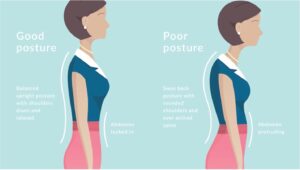by Gaynell Anderson, DPT, CMPT, CHC
Research has concluded that posture affects and moderates every physiological function in the body with the beginning of disease processes (chronic inflammatory diseases included) starting with postural distortion. (Lennon et al #1) If we demonstrate “bad” posture, this is the first clinical sign that imbalance exists, and a system is negatively affected. The negative effects of poor posture can manifest itself in symptoms including but not limited to vertigo, arthritis, cardiac disease, dementia, pain, and cancer. What is even more intriguing and devastating, is that the most significant influences of posture are on respiration (breathing), oxygenation (nutrients carried to tissues), and sympathetic function (rest and repair). (Lennon el al #1).
What this means is that the balance between injury and recovery is directly affected by our posture and posture is one of the primary visual signs of whether we have balance in this area or not! Remember balance between injury (fight or flight/stress) and repair (recovery) is the precursor to optimal healing and health. If we have imbalance or “distortion” in our posture, this is a noticeably clear indication that the organs (systems) responsible for recovery are not in a good working position to perform their job, so therefore recovery is negatively affected. (2) If your posture is aligned as it should be, your physical body is balanced and indicates good working position for all your systems, particularly those necessary for repair…Kudos to you!!
What is optimal posture? Optimal posture has two key components: the first being alignment and the second being engagement of core muscles to hold us in this alignment in various positions and in movements through space.

Correct alignment begins with the position of the pelvis and spine. Looking face to face at an individual standing, good posture shows symmetry between the right and left sides. Looking at an individual standing from the side: the ear, shoulder, hip, knee, and front of ankle should line up and the spine should have a curvature at the neck, slight curvature in the mid-back, and curvature in the low back areas. If, for example, the curve in the neck is too large, the vestibular nerves exiting the upper neck can be irritated/compressed reducing communication causing dizziness, imbalance, or vertigo. (3) If the curve in the low back is too large, the sciatic nerve can be irritated and cause pain or weakness in the legs. (4) If there is imbalance between hips or between shoulders, pain or weakness can occur in the arms or legs. If there is too large a curvature in the mid-back, breathing is impaired (1), and all hell breaks loose in our recovery system!
The point is to understand that most ailments should be considered resulting from imbalance between muscles, and quite repairable given attention soon enough. Most ailments today should not be considered irreparable and something we just have to “live with!”
The second component of optimal posture entails the work of our core muscles to hold this posture in space. Balanced positioning of the pelvis and spine minimizes core muscle work necessary to maintain this position. (5) This is important because, in this neutral/balanced position, the core muscles do not need as much energy, allowing for more energy (nutrients and oxygen) to be transported to the organs of recovery. Given this fact alone, the involvement of our core muscles is paramount in promoting optimal recovery health.
A good start to optimizing your recovery health is getting a postural assessment to determine imbalances in your neuromuscular system and begin specific training to regain your postural balance and optimize your recovery health!
Contact us today to schedule a session with Gaynell!
(239) 877-1481
Info@TriCoreWellness.com
References:
- Lennon J, Shealy N, Cady, RK, Matta W et al. Postural and Respiratory Modulation of Autonomic Function, Pain, and Health. American Journal of Pain Management. 1994;4 (1): 36-39.
- Peterson Kendall F, Kendall Mc Creary E, Geise Provance P, McIntyre Rodgers M, Romani WA. Muscles: Testing and Function. 5th Lippincott Williams and Wilkins. Baltimore, MD. 2005
- Yun-Hee Sung. Upper Cervical Spine Dysfunction and Dizziness. Journal of Exercise Rehabilitation. 2020
- David D, Maini K, Vasudevan A. Sciatica/book copyright 2021, StatPearls Publishing LL.
- Posture-Health Facts. ND Health Facts March 1, 2016.



